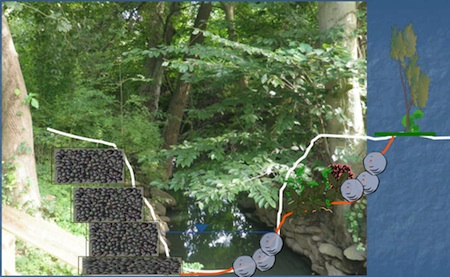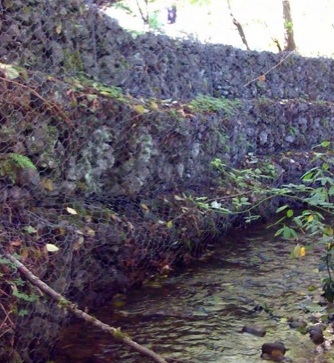Trustees Consider New Proposal For Stormwater Improvement Plan at Harcourt Woods
- Thursday, 13 June 2013 11:37
- Last Updated: Wednesday, 17 July 2013 16:37
- Published: Thursday, 13 June 2013 11:37
- Hits: 4056
 Now that the storm water improvement projects at George Field and Cooper Green nears completion, the Scarsdale Board of Trustees is moving their focus downstream to Harcourt Woods below Scarsdale High School. On Wednesday June 5th, the Board of Trustees met once again with Robert DeGiorgio of Dvirka and Bartilucci Engineers to discuss a revised plan to improve storm water management in the South Fox Meadow Area, namely Harcourt Woods.
Now that the storm water improvement projects at George Field and Cooper Green nears completion, the Scarsdale Board of Trustees is moving their focus downstream to Harcourt Woods below Scarsdale High School. On Wednesday June 5th, the Board of Trustees met once again with Robert DeGiorgio of Dvirka and Bartilucci Engineers to discuss a revised plan to improve storm water management in the South Fox Meadow Area, namely Harcourt Woods.
Harcourt Woods, the wooded area adjacent to the high school and north of Scout Field, is the seventh and final segment of a comprehensive storm water management plan for the South Fox Meadow area of Scarsdale. The other six segments include George Field Park, Cambridge Road, Cooper Green, Post Road, Murray Hill and the gravel parking lot at the High School. Each of these segments has been deemed a strategic area and has undergone alterations to facilitate excess storm water. George Field Park and Cooper Green have been transformed into dry detention basins that store water in order to protect against flooding and erosion. The open watercourse along Post Road is being de-silted and re-channelized to help eliminate the bottleneck and reduce overall peak flows. As is evident, each of the seven segments requires individual maintenance and plans to improve water flow in Harcourt Woods are now in the works.
The goals of this project are:
-Sediment and erosion control
-Storm water conveyance
-Erosion protection for Scout Field and the high school tennis courts
-Improvement of water quality
-Management of invasive plants.
To fulfill these goals, D &B has devised a comprehensive plan to de-silt the watercourse, install a sediment trap, create a Gabion Wall, install a maintenance access trail, divert the storm water away from Brewster Road remove some trees and plant others.
A key aspect of this project is the creation of a sediment trap. A sediment trap is a device installed to capture eroded soil that is washed off during a rainstorm. This trap will remove sediment and debris from Brewster Road before it reaches South Fox Meadow and thus protect the water quality of nearby streams and ponds. The sediment trap is not the sole modification to Brewster Road which will also have up to 1,100 feet of new catch basins and rain piping and 900 feet of curbing and walkway additions. The curbing on Brewster Road will improve the flow of water at the high school by capturing water and stopping it from entering the HS parking lot. "It is not going to be a 100% solution for the parking lot, but will be an enormous improvement," said DeGiorgio. These changes will lead to more efficient water capture, improved water quality, and most importantly, reduce flows to the South Fox Meadow Brook.
DeGiorgio explained that the Fox Meadow Brook now meanders through Harcourt Woods in a hooked path that may have been diverted at an earlier time. The current stream bank encroaches on Scout Field and borders the high school tennis courts. The stream bank is eroding and there are many dead and dying trees in Harcourt Woods, which at some points obstruct the watercourse.
"Erosion control is also critical to keeping sediment out of the system," says Rob DeGiorgio. It is especially important to mitigate erosion along the Fox Meadow Brook because it deteriorates the stream banks, allowing for water to overflow and excess sediment to deposit in the brook. According to Rob DeGiorgio, this sediment is "the number one pollutant" and yields an overall poorer water quality in the watercourse.
To restore the stream bank and remedy erosion, D & B will install an 800-foot Gabion Wall along the banks of the Fox Meadow Brook.  A gabion, which comes from the Latin cavea (meaning cage,) is essentially a cylinder, most often used in civil engineering, that is filled with rocks, concrete, sand and soil and built for the purpose of erosion control. This particular Gabion Wall's composition is a mixture of plastic, metal and stone. The wall is enclosed in mesh, which includes live plant stakes that will grow to form vegetation, making it appear "more natural than a cement wall" says Mr. DeGiorgio. However, the four-foot wall may initially appear to be an eyesore, as "it will take about a year for the foliage to fully grow along the wall." In terms of functionality, the wall will soften the current, steep vertical walls of the stream bank and turns in the watercourse will be removed. This would facilitate the brooks' flow through the woods, prevent further erosion of the stream bank and protect tree roots along the watercourse. According to D&B, this Gabion Wall has a "useful life of over 20 years" so "there is no reason why it wouldn't be there for quite some time." So while it is not a permanent fix, the Gabion Wall appears to be the best option for long-term erosion control.
A gabion, which comes from the Latin cavea (meaning cage,) is essentially a cylinder, most often used in civil engineering, that is filled with rocks, concrete, sand and soil and built for the purpose of erosion control. This particular Gabion Wall's composition is a mixture of plastic, metal and stone. The wall is enclosed in mesh, which includes live plant stakes that will grow to form vegetation, making it appear "more natural than a cement wall" says Mr. DeGiorgio. However, the four-foot wall may initially appear to be an eyesore, as "it will take about a year for the foliage to fully grow along the wall." In terms of functionality, the wall will soften the current, steep vertical walls of the stream bank and turns in the watercourse will be removed. This would facilitate the brooks' flow through the woods, prevent further erosion of the stream bank and protect tree roots along the watercourse. According to D&B, this Gabion Wall has a "useful life of over 20 years" so "there is no reason why it wouldn't be there for quite some time." So while it is not a permanent fix, the Gabion Wall appears to be the best option for long-term erosion control.
Another crucial aspect of this operation is removing trees that impede the flow of the stream. D&B has identified approximately 50 dead, fallen or endangered trees to remove. Though residents have expressed concerns about the removal of these trees, DeGiorgio said that Harcourt Woods is not being transformed into a detention pond like George Field and Cooper Green where there was massive tree removal. In this case, a few trees will be removed and replaced with new ones that don't impede stream flow. The revised project includes the planting of 28 new trees, along with dozens of shrubs, to replace what is removed.
This project is estimated to cost $1,000,000, a $50,000 increase from the prior proposal in October 2012 due to the difficulty of working in that area. "The space in Harcourt Woods is tight and the work is very labor intensive which increases the cost," says Rob DeGiorgio. This price increase is also due to the inclusion of tree and shrub planting, which was not in the original proposal but added after residents expressed concern about the potential loss of trees. Some also questioned the project from a cost/benefit perspective. Deb Pekarek wondered if it "would provide sufficient benefit to warrant the price tab." The cost of the project will be partially underwritten by a grant from Westchester County and construction is slated to begin this summer.










